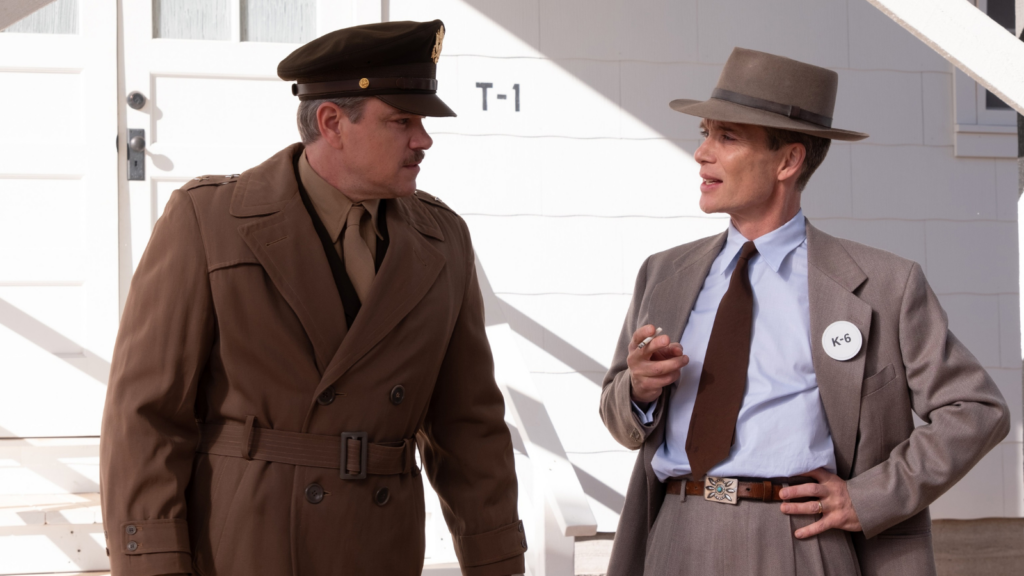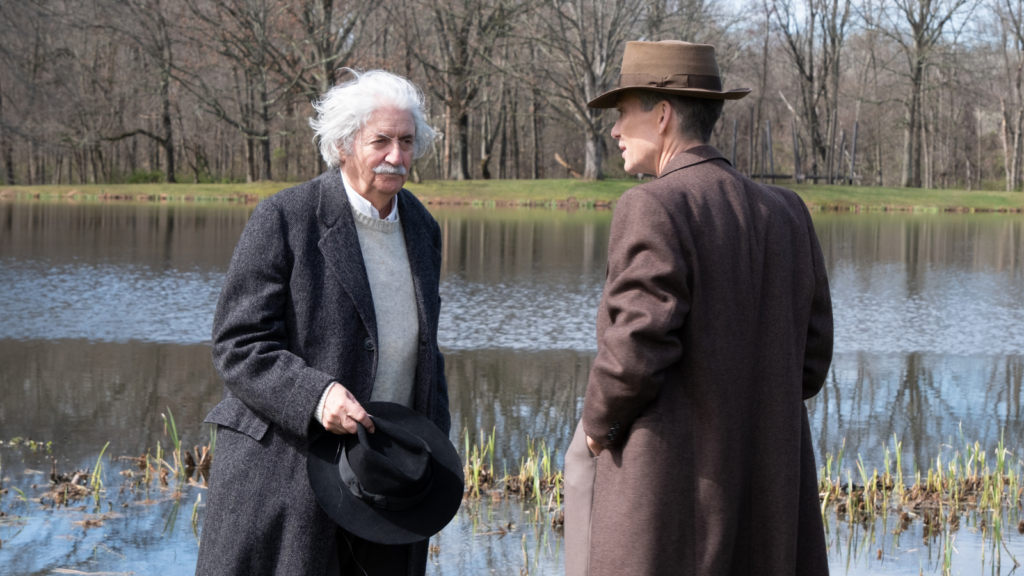We’ll admit we weren’t particularly excited to learn that Christopher Nolan’s Oppenheimer would be a biopic when it was announced in 2021, despite being long-time fans of the writer-director. After the visually impressive, wildly ambitious, and often-polarising Tenet, we were hungry for another expertly-crafted mind-bending film.
How foolish we were to doubt Nolan would deliver.
We quickly warmed up to the film ahead of its release with every subsequent casting announcement linking yet another award-winning actor to the project. Then, the pre-release buzz around Nolan’s almost-exclusive use of large-format IMAX cameras, along with a completely new large-format black-and-white film stock specially developed by Kodak, grew our excitement exponentially.
Despite the height of our excitement and expectations going in, Oppenheimer somehow managed to exceed them during its 180-minute runtime.
Not just about the bomb
 Oppenheimer – which was inspired by Kai Bird and Martin J. Sherwin’s Pulitzer Prize-winning book American Prometheus – chronicles the life and legacy of Julius Robert Oppenheimer, better known as J. Robert Oppenheimer or just Robert. He was an accomplished American theoretical physicist, director of the Manhattan Project’s Los Alamos laboratory, and widely regarded as ‘the father of the atomic bomb’, portrayed in this film by Irish actor Cillian Murphy (Peaky Blinders).
Oppenheimer – which was inspired by Kai Bird and Martin J. Sherwin’s Pulitzer Prize-winning book American Prometheus – chronicles the life and legacy of Julius Robert Oppenheimer, better known as J. Robert Oppenheimer or just Robert. He was an accomplished American theoretical physicist, director of the Manhattan Project’s Los Alamos laboratory, and widely regarded as ‘the father of the atomic bomb’, portrayed in this film by Irish actor Cillian Murphy (Peaky Blinders).
But Nolan didn’t just want to tell Robert’s story, someone he’s called “the most important person who ever lived.” He wasn’t only interested in Robert’s early years, or his time in the Manhatten Project during the final years of World War II, or his contributions to the first ever detonation of a nuclear device, or the years that followed when his security clearance was revoked as the US entered the Cold War.
He wanted to pull the audience into the psyche of the man in the centre. To reveal the risks he faced, the fears he had, and the ethical dilemmas he grappled with. He wanted to show the psychological weight Robert had to contend with. The weight of knowing he was responsible for not only killing hundreds of thousands of Japanese people but that he also helped unleash a terrifying force into the world that could, quite literally, result in its destruction.
That’s exactly what Nolan did.
Now I am become movie
But he didn’t do it alone. Dressed with his character’s signature porkpie hat and pipe, Murphy’s on-screen resemblance to Robert was eerie but it was the expressive nuance and emotional depth his face and eyes carried that really impressed. It made the psychological weight of his character’s burdens palpable as if they were physically weighing down on his face to create the hauntingly gaunt look associated with the man today.
 Murphy’s stellar performance was not the only one that stood out from the cast of Hollywood A-listers. Robert Downey Jr. plays Lewis Strauss, a former chairman of the US Atomic Energy Commission. He starts out as Oppenheimer’s ally but eventually tries to destroy his political ambitions and tarnish his legacy after Robert publicly humiliates him.
Murphy’s stellar performance was not the only one that stood out from the cast of Hollywood A-listers. Robert Downey Jr. plays Lewis Strauss, a former chairman of the US Atomic Energy Commission. He starts out as Oppenheimer’s ally but eventually tries to destroy his political ambitions and tarnish his legacy after Robert publicly humiliates him.
We’ll admit we were apprehensive about Downey’s casting. Could he be seen as anyone other than Iron Man after living in that role for the last 15 years? Downey’s performance answered that with a resounding ‘yes’. His portrayal of Strauss’ duplicitous nature amounts to one of the best performances of Downey’s career. We expect to see both Murphy and Downey among Oppenheimer’s nominations at next year’s Academy Awards.
Their names will not be the only nominations that this film receives. Nolan will almost certainly join them for his direction of this biopic. Working with talented actors is great, but if a director doesn’t properly use them, the movie will suffer.
Just looking at the stacked cast list and knowing the biggest names in the business accepted one- or two-line parts with five minutes of screen time should tell you what actors think of working with Nolan.
 Matt Damon recently admitted he promised his wife he would be taking a break from acting to spend more time at home “… unless Nolan called.”
Matt Damon recently admitted he promised his wife he would be taking a break from acting to spend more time at home “… unless Nolan called.”
Luckily for Murphy, Downey, and the rest of the cast, their performances have been amplified by Director of Photography Hoyte Van Hoytema’s cinematography and Nolan’s choice to shoot most of the movie with the 70mm IMAX film system which he reckons is “the highest quality imaging format ever devised.”
We’d love to be able to agree with him but there are only about 30 cinemas around the world capable of showing the movie in this format, the closest one being in Prague. But even though we can’t see it in all its 70mm glory, every version of the film benefits from using the best possible format from the outset.
Quantum theory becomes reality
Fantastic direction and gorgeous cinematography aren’t Oppenheimer’s only strengths. The editing, musical score, sound design, production design, and visual effects are all masterclasses in their own regard which culminate at the film’s zenith – the moments leading up to, during, and after Robert’s team carries out the Trinty Test, the first-ever detonation of a nuclear bomb.
The atmosphere of the film leading up to the famed button press is intensely thrilling and one of our favourite pieces of cinema, despite the fact that we know how it ends. Explosions don’t tend to take that long but Nolan draws this one out, forcing the audience to experience the moment as Robert did.
First, you see the blinding light, then you hear the rumble as the atoms of enriched plutonium are ripped apart. Finally, you’re rocked by the shock wave of the blast. They still haven’t figured out how to simulate that in a cinema but the IMAX theatre we were in had the volume turned up to 11 so our experience was pretty close.
 Despite Nolan’s love of practical effects, there was little chance of him detonating an actual nuke or recording the quantum mechanical theories swirling around Robert’s head. Yet, through the use of a few excellently conceived in-camera shots and some digital help, Nolan, his editor Jennifer Lame, and the visual effects team from DNEG managed to effectively portray the nuclear reaction and translate the theories in Robert’s head into a visual language the audience could comprehend without requiring a Ph.D. in physics.
Despite Nolan’s love of practical effects, there was little chance of him detonating an actual nuke or recording the quantum mechanical theories swirling around Robert’s head. Yet, through the use of a few excellently conceived in-camera shots and some digital help, Nolan, his editor Jennifer Lame, and the visual effects team from DNEG managed to effectively portray the nuclear reaction and translate the theories in Robert’s head into a visual language the audience could comprehend without requiring a Ph.D. in physics.
Oppenheimer isn’t without its faults. The three-hour-long runtime is sure to put a few people off, but we wouldn’t call it a fault here. Although the pacing did feel uneven at times, the speed at which important information is thrown at you and the quick transitions between Nolan’s engrossing multi-tiered storytelling structure make the time fly by.
The transitions might be a little confusing for some viewers when trying to place the pieces of history together in a linear timeline. It also doesn’t help that Nolan switches between colour and black-and-white, a technique he’s used before in Memento. Only this time, he uses the different film stocks to convey the difference between a subjective perspective, how Robert perceives the world, and an objective one – how it really is.
Another Nolan-ism that makes a reappearance in some scenes was a muted dialogue track where we struggled to discern what someone said. The same complaints have been levied at Tenet and while we didn’t notice a problem in that film, there were a few scenes where it crept in here (despite our theatre cranking the volume).
Oppenheimer verdict
This film isn’t going to be enjoyed by everyone. If you don’t like the idea of a three-hour-long dialogue-heavy biopic about the life of one man, we’ve heard Barbie is pretty good. Go watch that instead.
But if you’re even vaguely interested in the subject – whether that be the man or the ethical conundrum of deciding to drop a nuke – or you just want to watch a well-made movie, Oppenheimer is well worth your time — especially if you can see it at an IMAX theatre.
Nolan accomplishes everything he set out to do and seemingly does so with ease. As if he wasn’t even trying that hard. It is an artistic and intellectual triumph and arguably his best work yet.
The fact that the questions Oppenheimer leaves you with, like ‘Should they have done that?’, can be applied so easily to recent conversations around AI is just the cherry atop this relentlessly thrilling cake.




